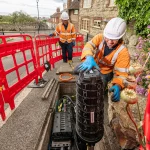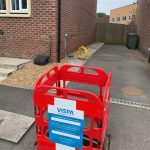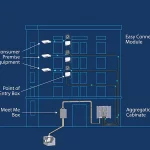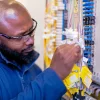ISP BT Pause UK Digital Voice Rollout After Consumer Complaints

Broadband ISP BT has paused the national UK rollout of their new Voice-over-Internet-Protocol (VoIP) style Digital Voice product after complaints due to recent service outages. The service is designed to replace their old analogue phone service and is typically offered alongside broadband packages.
Hopefully by now most people will be aware that Openreach (BT), much like other network operators across Europe with a legacy of older copper infrastructure, is in the process of moving all of their lines away from the old analogue Public Switched Telephone Network (PSTN) and on to a fully digital network, which is due to be completed by December 2025.
We first began reporting on this change in more detail all the way back in 2017 (here). A number of reasons exist for this change, not least of which is the inevitable switch to gigabit-capable Fibre-to-the-Premises (FTTP) based broadband lines (it is not economically viable to retain both old and new networks) and the fact that very few people today make much use of their landline phone (most prefer mobile, VoIP and internet messaging).
Advertisement
Like it or not, the old analogue voice and copper line infrastructure is destined for the rubbish bin of history, and many will be happy to see it go. As a result of this, ISPs have had to adapt to offer broadband connectivity as their primary product, with phone (voice) services becoming more of an optional add-on (offered via VoIP on the same internet connection).
Service Disruptions
However, many consumers often only become aware of such transitions once they start to be directly impacted by them. The problem is that replacement VoIP solutions do have the odd caveat, and some of the most vulnerable people are starting to notice.
The first problem is that consumers, even landline-only customers, will need a broadband connection, and this makes the setup a little more complex (e.g. you must plug your old analogue phone into the router, an ATA adapter or change handsets – more details). The next challenge stems from the fact that a lot of older systems, such as building alarms and remote medical monitoring devices, have not been adapted to work with digital voice solutions.
On top of that, people often forget that the old analogue copper phone lines were remotely powered, which meant that even in a power cut you could still connect an analogue handset into the wall socket and make calls. But to do this with VoIP would require battery backup (Battery Backup Solutions) for your handset, router and ONT (the latter is only relevant if you have FTTP) – these will also only last for so long (a few hours, at most). Hard luck if you need to call 999 in an area with no mobile signal during a protracted outage.
Advertisement
Suffice to say, the recent storms left many people to suffer from lengthy power cuts and those who had been migration to a VoIP style product (e.g. customers of BT’s Digital Voice) suddenly came face-to-face with these caveats – particularly those in areas where mobile signals don’t exist or are unreliable.
So far BT has, perhaps unfairly, taken the brunt of the flak for all this, which is despite the fact that it’s an industry-wide change. But this may partly reflect the fact that BT’s customer base includes a higher proportion than most of landline-only phone customers, which are the hardest group to tackle as they’re often also amongst the most vulnerable.
BT’s Response
BT has responded to all the negative stories about its Digital Voice transition by choosing to pause part of the migration process, while admitting that it made a mistake. None of the other providers going through this same transition have acknowledged the same difficulties, despite the fact that many of the same caveats will apply.
Marc Allera, CEO of BT’s Consumer Division, said:
“We underestimated the disruptive impact this upgrade would have on some of our customers. With hindsight we went too early, before many customers – particularly those who rely more heavily on landlines – understood why this change is necessary and what they needed to do.
We also recognise we have more work to do on getting better back-up solutions in place for when things disrupt the service like storms and power cuts. We got this part of our programme wrong and for that, we’re sorry.
The huge disruption caused by recent Storms Arwen and Eunice brought this into sharper focus, when people – including many of our customers in rural areas – needed to get in touch with loved ones during power outages. While many lines were cut in those storms, including the older phone lines, as well as power lines – we do recognise that for some customers, making calls would not have been possible with a broadband-only connection.”
The operator will apparently now only transfer customers to Digital Voice when they request it (except those on their legacy ‘Fibre Voice Access‘ product as this needs to be replaced) and they’re also working with energy providers on faster power restoration. Naturally, new customers in FTTP-only areas will also only be able to get Digital Voice, as the copper alternative may not exist.
Advertisement
BT will also continue their rollout for customers in Salisbury and Mildenhall, where Openreach has been working closely with BT and other ISPs to trial the retirement and withdrawal of old, analogue landline technology. “It’s important we continue this work so that we learn how to upgrade customers in the smoothest, most efficient way,” said Allera.
On top of that, BT are looking to produce longer-lasting Battery Backup Units (BBU) for those who need one (vulnerable customers) and are planning to introduce new “hybrid phones” (handsets), which can automatically switch the Digital Voice to a mobile network (signal allowing) when broadband is lost. Hopefully they don’t hobble the latter by forcing customers to only take their own mobile service in order to benefit.
BT’s Planned Digital Voice Changes
➤ Hybrid phones that can switch to a mobile network and have an in-built, long-lasting battery.
➤ The option of longer-lasting battery back-up units for customers who want or need them.
➤ Providing in-home ‘mobile landlines’ for people without broadband.
➤ Addressing so-called mobile ‘not-spots’, with continued investment in the Shared Rural Network. We’ve recently announced a further 1,500 locations that will get better coverage as a result.
➤ Launching an awareness campaign so that our customers better understand the need to switch.
➤ Continuing to proactively engage the related industries – like healthcare pendants and burglar alarm providers to ensure our most vulnerable customers continue to get the service they need.
➤ And we’re continuing to work on other things, too, including advancements to scam-call shielding and fraud reduction tools, that we know are becoming ever more important to our users of landlines.
BT states that they have 10 million customers to upgrade to Digital Voice by 2025, but they’ve pledged to keep the migration on pause until they have all the key solutions in place, which we think could take quite a few months (unofficially BT suggests it could be later this year or early 2023).
However, it’s worth noting that there isn’t a total fix for all the core issues, and battery backup units will only ever last so long. Another issue with battery units is that they may only cover one device, but in a modern FTTP setup you’d need it to support at least two – router and ONT (possibly three if the handset also requires mains power). The reality is, there’s only so much an ISP can do.
As for BT’s Enterprise customers, they will be upgraded to a different, business-focused IP voice product, so are “not affected by this temporary pause“. BT’s Enterprise business will begin to proactively contact customers in phases over the coming months to advise on timescales and process for upgrading to new Digital Voice and broadband products.
Mark is a professional technology writer, IT consultant and computer engineer from Dorset (England), he also founded ISPreview in 1999 and enjoys analysing the latest telecoms and broadband developments. Find me on X (Twitter), Mastodon, Facebook, BlueSky, Threads.net and Linkedin.
« North Yorkshire UK Completes Rollout of Free WiFi to 20 Towns UPDATE






















































The trouble with the Digital Voice set up is that I would need three devices to have battery backup, ONT, Router and Phone.
Were these one piece of kit, it would be straightforward, however with three we are talking about needing one of those UPS systems reviewed earlier on ispreview.co.uk in the year.
So perhaps BT need to make the ONT, Router and digital voice handset one piece of kit with some sort of battery back up.
This is where having the VoIP (a BT socket) in the ONT made perfect sense, as then only one bit of kit needed backup power on transition to FTTP, and this was indeed how FTTP was delivered in the beginning. I guess this was too costly and Openreach no longer wanted to deal with the voice aspect of being a telecoms company so it is no longer used.
Having a phone that does VoIP and mobile is also problematic. In an emergency when phone lines go down there may not be enough capacity to suddenly deal with these extra terminals on the mobile network. They also would need to support 4G and 5G for audio (VoLTE) and this is more costly. I bet currently these devices just contain a cheap 2G radio and will stop working in a few years.
Even without storms and power-cuts you can’t rely on the mobile phone network. For example when the lockdown was announced, a few minutes after a relative called me from their mobile in a panic, the call dropped after a minute and attempts for me to call them from my mobile and vice versa failed, as presumably too many people were using the mobile network. All that worked was landline-to-landline.
Basically the good old reliable landline is being scrapped, it’s replacement is just a pseudo landline, it will never be as reliable. That is progress for you.
The trouble with digitising is it leaves EHS sufferers (that mobile signals make unwell) desperate and prospectively without communication devices.
So good news and bad news.
Telephone services over copper landlines wili be retained – Hooray!
The cost of providing this service will fall on those customers who want it – Boo!
If you want something you should pay for it.
I was forced to take it… I like it but my issue with it is that your forced to use smart hub 2. All that waste of having to upgrade routers is madness..
You don’t if you buy a newer landlines phone it works through the WiFi instead.
BT need to use the port on the ONT for phone and not plug into their router. This would hopefully allow easier transition between ISPs and allow use of your own router instead of an ISP’s but keep the ISP phone service (without having to resort to using your own VOIP provider and number to be independent of a phone service that only works via the ISP’s own router). Hopefully this is possible?
I appreciate the reasons for keeping the Openreach’s ONT separate from the telco’s router. But surely it would be possible for the manufacturers to supply ONTs and routers which plug in together to form a hybrid unit with one power supply?
People: BT should replace copper with fibre.
BT: *starts doing so*
People: nooooo!
I agree with other comments that perhaps the voice port should have remained in the ONT, it would make it the equipment less confusing to setup for the less tech savvy and would reduce this problem by only requiring the ONT to have a backup.
However, it makes a lot of sense for Openreach do ditch the voice aspect for the ISP and just be concerned with the ethernet out. It makes the handover between Openreach and the ISP easier.
I suspect BT will just make a small DC UPS with 2 outputs, one for the router and another for the ONT. The phone doesn’t need powering as the router already provides enough power over the voip port for a basic phone, like before.
Maybe they’ll decide to put a voip port in the ONT but I think that ship has sailed…
With the coper landlines BT used to only have at most 24 hour battery back up. If the power cut was for longer they would need to bring in a mobile generator
Except for the local loop though the network is already IP based
A big problem at present is that sensible battery back up options are not easily available
Mobile handset as well have only limit capacity for the battery runs out
If there are power cuts it is best to only make essential calls and keep them short
I think many of the complaints will not just be down to having no phone in a power-cut, after all many people already experience that due to having DECT phones with a mains powered base station.
I suspect the complaints are more wide ranging, such us general unreliability. You have many more things to go wrong with a VoIP phone: Resync’s of the VDSL/ADSL signal causing interrupted calls, packet loss issues causing bad call quality, firmware updates to routers breaking things, losing configuration settings due a factory reset/crash of, or replacement hub/router. Unable to contact support on losing broadband as no phone. VoIP supplier problems where they have a service interruption, and all sorts of configuration issues with peoples own kit. A noisy telephone line still allowed a call to be placed and understood, but switch it to ADSL/VDSL to go Digital Voice and now you can barely say a few words.
Phil – probably worth noting that an ISP supplied service will have fewer inherent issues than an over the top service. I suspect BT prioritise the voice traffic and of course they own the router, no misconfiguration issues as you cannot use your own SIP phones. Broadband line issues can arise, but then PSTN also isn’t flawless (crackles etc) and neither will withstand a JCB going through the cable!
Even before the arrival of VOIP, by switching to cordless phones many vulnerable customers have unwittingly become dependent on mains power for a working telephone.
Very true.
With the announcement about supplying “in home” landlines (using mobile) and improvements for mobile signal I expect many of the complaints slow down/disappear.
And the areas where mobile signal won’t be improved either down to Planning and Public opposition, whats going to be the solution for them?
@Mark – I don’t know myself but pragmatically at some point the public opposing change will have to accept some form of solution or accept having no connectivity (whether data or voice).
They can’t have it all ways.
If you look at Openreach changing the approach for wayleaves (to overcome difficulties with absent landlords) it would not be a big step to see EE’s mobile infrastructure team do something similar to achieve coverage in extreme situations.
That’s where the problems lie, the areas of the UK which have poor coverage aren’t always completely rural, wayleaves or any planning yby BT won’t make any difference if councils the area AONB,Conservation areas and I’m most cases the vocal minority stop builds, they even oppose the green equipment cabinets and some neve got built in the Conservation area streets of the area, this is a mess getting worse and will cause a bigger divide.
I personally wasn’t particularly impressed with how this switch over has been effectively pushed through with little consultation or consideration for the elderly or vulnerable. They don’t all or want or can use mobile phones.
Emergency access to communications is vital, and it seems they have largely been ignored in this roll out with no real solutions being presented before switching over thousands of properties.
If, as they were required to provide backups for copper landlines for emergency phone access, they should have been made to do the same with VOIP, not wait till theirs a public outcry over if. No point advancing technology when it ends up being less useful or effective or usable then what it’s replacing.
Perhaps they should develop very simple mobile phones and offer those to the elderly ensuring they can get mobile reception in the homes as a potential solution.
Why on earth didn’t the regulator insist on these issues being sorted out BEFORE allowing the “upgrade” programme to proceed? Ofcom has been asleep at the wheel.
If a customer has no mobile phone. They are provided free of charge by BT incase of emergency
I’ve been forced on to BT DV system, and quite frankly, it’s crap. What you don’t see on the main page of advertising the service, is that to get HD calls, the other person needs to have the BT DV service and phone.
The standard call quality of my DV service is abysmal. Calls are quiet and muffled, and there’s a lot of noise. It’s worse than the call quality of my older copper line.
The other end needs to be HD (of course) but it doesn’t have to be BT – I’ve had calls with mobiles that are in HD.
As for non-HD calls, it sounds slightly better than the PSTN did to me – since the analogue part is reduced from a couple of kilometres down to a few inches. If you’re having problems with the quality it sounds like you have a fault.
I was told by “Distinguished sage’s” on the BT forums that to have an HD conversation, the mobile has to be either EE or BT using VoIP. For the DV service, the other end needs to be DV as well.
Either way, this is what it says on the BT site:
“It’s time to bring landlines into the digital age. Get ready to combine the convenience of your home phone with the clarity of HD, with Digital Voice. To experience HD quality calls and great new features, just plug in your new home phone (that we’ll send you for free) and you’re ready to go.”
That’s extremely misleading.
@TinaT, you can have HD calls between different mobile providers, but both mobiles need to support it, and you don’t get HD if one end is using a 2G signal. I get HD calls from all operators but not consistently. However given mobiles have tiny speakers, the improved audio quality is not always that noticeable unless using headphones.
VoIP needs both ends to agree on the codec and is a bit more complex having a mix of incoming calls from landlines, mobiles and other VoIP providers. The trick with VoIP is to make sure you have specified your codecs priority to use from best to worse. Even then the best codec is just 64Kbit/sec, and most codecs are old, from the 1970s in some cases and continue to be used as they are out of patent so no licensing costs, and none of them sound brilliant. However phone calls even on old analogue phones over wires get converted to the same codecs, so it should be comparable.
Not really sure how it’s misleading. If you have Digital Voice, you must have the smart hub 2, and (unless you choose otherwise) you will have the fancy new DECT handset that goes with it. With those two items and assuming the other end is capable of HD, that’s what you will get.
No different to when the HD Voice rollout happened on mobiles, for a while it did depend on who you were calling but more phones supported it & the networks put in the necessary infrastructure to allow HD calls between different operators.
Even if it isn’t an actual HD Voice call, depending on how good your old line & handset was then there’s still a quality gain to be made.
@Ivor
How can you say it’s not misleading?
I was pushed on to DV and I was provided a link to the DV website. At no point did it mention that you will only get HD calls if the other user is using a digital service.
Read this again:
“It’s time to bring landlines into the digital age. Get ready to combine the convenience of your home phone with the clarity of HD, with Digital Voice. To experience HD quality calls and great new features, just plug in your new home phone (that we’ll send you for free) and you’re ready to go.”
^ That statement is simply untrue, there’s absolutely no defending it.
I know nobody using a digital voice service, so I won’t be getting HD calling, despite their claim.
Call quality is crap, period.
I’m also getting bombarded with cold calls. I keep adding them to a blacklist, but more arrive with a slight variation on the number. According to BT, there’s a database in place to stop help prevent it. I’m still getting 10 a day. I had no such problem on the older service.
Back to DV, BT should be hit with an Ofcom order to change their wording about their service. It’s unacceptable.
… because it’s not just other digital voice customers, but anyone else with an HD voice capable handset (including mobiles, and at some point other IP based landline and VoIP companies. Ironically this switchover pause means you might have to wait longer for any other landline users you call to get upgraded 🙂
Feel free to take it to the ASA if you feel so aggrieved about it – but I doubt it’ll get anywhere as the product and service are inherently capable of it.
As for your general quality complaint – take that up with BT. It’s clearly not an issue with DV itself as it seems to work fine for me and others – the primary complaint is resiliency during power cuts.
The majority of BT exchanges have large diesel generators fuelled from an underground fuel storage which would last for a considerable time before needing refuelling. This combined with the copper network gave a level of security which just does not apply to the new internet based locally powered systems which are in effect a return to the old concept of local battery which was used in the early days of telephony.
A small step to providing emergency voice communication during power cuts would be the provision of standby batteries and on site generators for mobile phone mast sites
If people want to retain an antiquated service they and only they should pay for it.
Well, if you’re already using DV, then you’re already paying for an unreliable service.
I’m happy to pay for something reliable.
I use a mobile, waste of money paying for an additional home phone.
Good for you using a mobile, your one out of 66 odd million people in the U.K.
No one is saying they shouldn’t pay for a copper service, but you seemed to have neglected the fact no one CAN pay for a copper service and have fibre to the door, until this announcement. And the fact they seemed to have planned little redundancy plans into the VOIP system which is amateur at best and very wrong, when copper has solutions in place, and you can still buy an old phone that isn’t cordless.
I got fed up reading through this thread, trying to find out what Openreach’s plans are for those people who only have ADSL Max as a choice (yes, you read that correctly, and I aleady *know* that it became obsolete over a decade ago…) and who get speeds of so many Kbps because they are miles and miles from the nearest exchange. Some of my neighbours – on the Isle of Skye – have a copper pair PSTN telephone and no broadband whatsoever… will they just have to rely on carrier pigeons after the 2025 copper switch-off?
Time and time again I get told that “they won’t be left out” but now it’s only three years away and so far no-one can even guess at how they will be catered for.
I’m “lucky” with (for here!) super-fast 4 Mbps!
All Cityfibre, B4RN etc. customers have this probem.
Not sure about the rest of the UK but CF use the TEL port in the ONT. Battery backup lasts about 3 hours with a conventional wired phone.
Unless CF is referring to someone else, Cityfibre use the one on the router.
I’ve moved my landline from vonage to deskphone which is a solution that runs on a sim although you can still have a voip box if you wish to run alongside it. So I have a dual sim phone: one is the landline and the other, my mobile. It works for me, we no longer have dect phones around the house. I appreciate that this setup is not for everyone, especially if the mobile signal is weak or non existent.
Our local mobile base station has no battery backup either, when our house loses power the mobile signal is also lost because we are on the same HV circuit as the cell. Not really joined up thinking..
Bear in mind that BT uses about 1% of the total national electricity consumption.
Getting PSTN turned off is actually quite a big step to reducing the national carbon footprint and also bills. Never mind the costs of maintaining a very old network that is EoL.
I agree that a solution needs to be found to combine the ONT and the Router/VoIP into one box that can be powered for a decent length of time. This is not impossible. As others have pointed out: reverse PoE could be part of the solution with the ONT accepting PoE. Realistically Router/Modem/VoIP can be in one box and it can/has been done.
That way no wheel reinvention is needed just a simple product tweak?
It might reduce BTs electric bill, but VoIP will use electricity, I’ve no idea if there will be a net gain or loss over the UK for power consumption. Powering a router with VoIP where the customer had just a telephone is going to draw power (10 watts continuously perhaps). You not only have the kit in the customers home plugged in drawing power 24/7 for the odd phone call where none was drawn before, you also have kit on BTs side drawing power to power up the xDSL circuit (unless it is FTTP).
Whilst not having to travel and repair aging telephone cable is a plus, the added complication of VoIP and customers with extra boxes to plug in with no idea what it all does will surely be adding a number of engineer call outs.
At the end of the day this isn’t about saving electricity, it is because more money is made by scraping the telephone service than keeping it. I’ve no problem with that and making profit.
Is any open-access infrastructure operator allowing that level of integration though. I can think only two ISPs that have gone down the path of moving the ONT into the router, and they don’t have wholesale services to worry about, it’s all theirs. Even then it’s actually an SFP slot to allow the use of the appropriate SFP ONT for the network.
Not to mention that the two box solution gives the fibre operator complete control and visibility of their equipment, they can be sure that at least up to the ethernet handoff that all is well. Not allowing the customer to fiddle with the fibre is surely another plus.
The least-effort solution will be some form of DC output UPS that can power both the ONT and the router for a sufficient length of time, no need for reverse power and other complexities. BT already offers a DC UPS for the hub only, though I don’t know what Openreach’s current solution is for the ONT
Phil – while there may be an overall increase for non-broadband users, I suspect that’s totally dwarfed by the savings for the majority. The VoIP hardware inside the router is going to add next to nothing compared to the per-line power consumption of 1980s telephone switches.
“It might reduce BTs electric bill, but VoIP will use electricity”
VoIP uses negligible amounts of power.
Part of the problem with very long DC powered copper lines is that you get leakage caused by moisture and other effects.
“you also have kit on BTs side drawing power to power up the xDSL circuit (unless it is FTTP)”
As BT/OR are building loads of FTTP that is the fair comparison on future power consumption. If 85% of the country are on FTTP then saving that sort of % is worth it.
As in every case, unless the household is POTS only, there is xDSL kit or FTTP kit on premises so the power consumption will be similar.
“Hopefully by now most people will be aware that Openreach (BT) […] is in the process of moving all of their lines away from the old analogue Public Switched Telephone Network (PSTN) and on to a fully digital network […]”
I think this is a huge misapprehension Mark! It might well be that most regular readers of this website are aware of this change, but if we take “most people” to mean most of the general public then I’m afraid I think you are very much mistaken!
“Like it or not, the old analogue voice and copper line infrastructure is destined for the rubbish bin of history, and many will be happy to see it go.”
The copper line infrastructure is of course sub-optimal for data transfer, but it really should to be acknowledged that in terms of reliability and simplicity the modern day PSTN for voice calls ‘just works’ the vast majority of the time. Replicating that reliability and simplicity for voice calls in preparation for the PSTN switch-off was always going to be a challenge, and so it is proving.
Ijust looked on the Ofcom website to see the the public’s responses to its consultation document on its proposals to hanfle the switch from PSTN to digital.
And I couldn’t find it. So did I not look hard enough or did Ofcom fail to consult? I would be happy to be proved wrong!
Well said, I was disappointed in the overall arrogance of Marks article, seemed very pushy of a ‘new technology is a must for the sake of it’ angle, ditch the old reliable service for something new and improved and doesn’t work as well.
I cannot believe the sheer total incompetence, and no doubt money exchanging hands, to push this VOIP through with no real scrutiny of the fact the voice service seems flawed by design and unreliable, no doubt cutting costs. Or maybe ministers were told about it and they chose to ignore it and instead insisted the switch over carry on so they could sell it to the voters.
Many places still can’t get good reliable mobile signals, the lack of investment, unwillingness to make government policies, the shouty minorities blocking planning permission of new masts, the lack of real scrutiny and proper design and cost of new systems, all coming to a head when the U.K. wants fibre to the door.
A strong stance needs to be taken really, but no one will do and I expect the charade to continue. And the U.K. will lag behind others as it normally seems to be the case with communications.
I just hope they do as this story implies and install fibre to your door, and then leave the copper and PSTN wall box in place for you to have a copper landline if you choose.
Good on them for pausing and listening but impossible to fix all of the possible issues.
e.g in a power cut even good battery backups are only going to last 3 or 4 hrs. And that’s if you’ve kept the battery charged and it’s in good condition.
3 hrs won’t help those who had outages of days like in recent storms. Even staying on copper won’t help if a pole comes down.
Good mobile coverage is the best bet with a few power banks, but even then the masts still need their power.
We also need to consider the usability impact on older people. My grandmother has used BTV for a while, and mostly it’s ok but occasionally the router won’t sync and needs a reboot (I think the line has a HR fault that BT can’t fix). She really can’t understand why she needs to turn things on and off when the old landline just worked.
Correction its not BTV – it is a SIP based service.
People need to learn that business and the government don’t care about them and they need to setup their own solutions if they are worried about losing power or service no company that wants to make profit will go out of their way to help them
Of course they’d stop a month after I left them in part because of the mid-contract switchover (I’m not a fan of the Homehub).
Here’s one thing that would have helped me, allow users to use third party software/hardware for telephony. I.e. so that I can use something like FreePBX like I now do with Sipgate.
When my broadband was down between switching providers, I was able to use the mobile for the ‘landline’ so I could still make/receive calls this way via the ‘landline’ number.
Obviously it’s not for everyone.
Sort of begs the question as to what we can reasonably expect BT to do. This isn’t the monopoly era GPO or British Telecom anymore – we made the decision to make telecoms a competitive sector and this will drive their big decisions, including shutting down an expensive network built for a different time and replacing it with a service that realistically works well enough for the very vast majority (and doesn’t apply at all to the increasing numbers of people who don’t want a landline phone)
i.e. why is BT taking all the flak and has the expectations to improve things when none of their competitors, including the more “legacy” providers like Virgin, have no such requirement. They’re all subject to the same regulations after all.
The trouble with BTs roll out is that they haven’t thought about the aforementioned power problem and making it accessible to backup units should a customer request one. Some customers I’ve spoken to despite being less techy and elderly BT aren’t treating them as ‘vulnerable’ and backup battery’s aren’t being provided or advice on how to get one despite requesting. Another issue is confusion as to why fall alarms and home alarms won’t work when clearly all that needs to be done is simply unplug the wire from the wall and replig it into the back of the router. Very poor from Openreach on this one for not making a national TV advert on the matter and BT not sending out guides through the post automatically.
Let’s be honest, they’ve only have 20 years to think this through. 1st attempt with 21CN, the FVA and now DV. Can’t expect them to think of everything!
I am amazed that OFCOM di not require basic battery back up for VOIP. Unkike a mobile space is not a serious contraint and for domestic use a couple of hours back up should do
Possibly the kit should be designed so that it auitomatically goes inyo power save mode if there is a power cut
Another pronlem is almost all the backups available are UPS’s which is overkill and expensive
The issue isn’t technology it is often commercial.
There really isn’t any reason why the ONT cannot:
*Be protected with a BBU and provide a FVA socket that is resilient and connected to existing telephone wiring.
*Extend the FVA connection from the OR handover point to the VoIP infrastructure
*Provide connectivity and login to a particular ISP
*Allow users to choose between ISP WIFI router, third party routers or home hubs that have that functionality.
*Provide PoE to such devices
I think BT have woken up to the fact that the current process created so many issues it was driving their existing customers away as there was no longer any good reason to stay with them for the landline whether it was the resilience, new devices, porting etc.
Do not kid yourselves that the most LOGICAL AND SENSIBLE approach will be taken. They do this to “look modern”, not because it is NEEDED.
The ofcom problem is the board of directors. Sachin Jogia is probably the only one with any clue about anything to do with technology of any type.
The government problem is having Nadine Dorris as their government go between. She has about as much knowledge and experience as a pickled onion.
It’s not that BT aren’t explaining properly.. they aren’t explaining *at all* and expecting people to just roll over. My elderly mother got told by BT they wanted to install a ‘digital box’ (couldn’t get her to explain more, and she wouldn’t have understood anyway) and charge her for it for what I believe was an upgrade to a digital exchange.. but she was basically ambushed with it, went to me for an explanation and I hadn’t got a clue either..
They need to be explaining this stuff months in advance, with proper leaflets (she doesn’t have broadband) explaining why and *not* charging people for something they didn’t ask for.
I was mis-sold Digital Voice by BT Mohammed at Burnley call centre. Not told of any of the disadvantages. I use Siemens Gigaset phones that give weather forecast, news, send/receive SMS, clarity of sound with a much better user interface, calendar, and more! The BT handset is out of the stone age in appearance. To cap it all where I live in the Lake District, the power fails often and in the winter for days at an end. No mobile signal here either so completely cut off.
I am using the Gigaset handset with the system but cannot send/receive SMS message. Still get the weather etc.
A big backward step and awful design.
BT refuse to but me back so will take it further.
I really don’t have a problem with BT DV but like many people, I now use the mobile for most calls. I am actually leaving BT but didn’t want to immediately lose the old home number since that number is known by many contacts etc. BT wanted to charge me £23 a month just to retain the number, but what might interest other people is that I am porting the number to another company, Sipgate who will provide a comparable service for nothing, but if I want to make calls I can, and for cheaper inclusive calls I can pay a reasonable monthly charge. Incidentally, the call package from Sipgate is still much cheaper than BT. I appreciate that doesn’t solve the issue of power cuts, but why pay for a service (DV) that is rarely used and aside from Sipgate, there are many alternative companies to BT offering digital VOIP solutions.
How is the fibre equipment in the local cabinet powered? Mains only, mains with battery back up or powered over cable from the exchange! Its ok supporting the exchange and customer equipment but what about the bit in the middle.